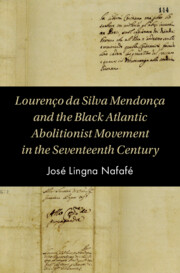Book contents
- Lourenço da Silva Mendonça and the Black Atlantic Abolitionist Movement in the Seventeenth Century
- Cambridge Studies on the African Diaspora
- Lourenço da Silva Mendonça and the Black Atlantic Abolitionist Movement in the Seventeenth Century
- Copyright page
- Contents
- Figures
- Tables
- Acknowledgements
- Introduction
- 1 The Municipal Council of Luanda and the Politics of the Portuguese Governors in Angola
- 2 Ndongo’s Political and Cultural Environment: Alliance, Internal Struggle, Puppeteering and Decline
- 3 The Journey of Mendonça: The Princes of Pungo-Andongo in Brazil
- 4 Mendonça’s Journey to Portugal and Spain, and the Network of the Hebrew Nation and Indigenous Americans
- 5 Mendonça’s Discourse in the Vatican: Liberation as a Wider Atlantic Question
- 6 Mendonça’s Quest for Abolition and the Tussle between the Portuguese Overseas Council and the House of Ndongo
- Conclusion
- Bibliography
- Index
6 - Mendonça’s Quest for Abolition and the Tussle between the Portuguese Overseas Council and the House of Ndongo
Published online by Cambridge University Press: 18 August 2022
- Lourenço da Silva Mendonça and the Black Atlantic Abolitionist Movement in the Seventeenth Century
- Cambridge Studies on the African Diaspora
- Lourenço da Silva Mendonça and the Black Atlantic Abolitionist Movement in the Seventeenth Century
- Copyright page
- Contents
- Figures
- Tables
- Acknowledgements
- Introduction
- 1 The Municipal Council of Luanda and the Politics of the Portuguese Governors in Angola
- 2 Ndongo’s Political and Cultural Environment: Alliance, Internal Struggle, Puppeteering and Decline
- 3 The Journey of Mendonça: The Princes of Pungo-Andongo in Brazil
- 4 Mendonça’s Journey to Portugal and Spain, and the Network of the Hebrew Nation and Indigenous Americans
- 5 Mendonça’s Discourse in the Vatican: Liberation as a Wider Atlantic Question
- 6 Mendonça’s Quest for Abolition and the Tussle between the Portuguese Overseas Council and the House of Ndongo
- Conclusion
- Bibliography
- Index
Summary
Chapter 6 investigates the debate about the freedom of enslaved Africans in the light of the tussle between Mendonça, his family and the Portuguese Overseas Council. The chapter examines the Crown’s slave legislation of 18 March 1684, seeing it as a direct response to Mendonça’s court case in the Vatican. It looks at the sphere of the Overseas Council’s jurisdiction in relation to the internal affairs of the kingdom, that is, Portugal, and its attempt to overturn Mendonça’s court case verdict in the Vatican via a discreet anonymous letter. It examines how Mendonça marshalled his legal arguments to uphold the Vatican’s verdict . The chapter argues that the court case was a tussle between Philipe Hari I and João Hari II of the House of Ndongo and the Overseas Council, which vetoed a decision that Philipe Hari I would continue payment of baculamento, that is, make tax payments in enslaved people. I contend that Mendonça, in taking his criminal court case to the Vatican, sought not only the abolition of African slavery and liberty for Indigenous Americans and New Christians, but also to shake off the burden of his own family’s involvement in the slave trade.
- Type
- Chapter
- Information
- Lourenço da Silva Mendonça and the Black Atlantic Abolitionist Movement in the Seventeenth Century , pp. 384 - 413Publisher: Cambridge University PressPrint publication year: 2022



